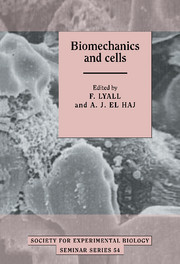Book contents
- Frontmatter
- Contents
- List of contributors
- PART 1 SOFT TISSUE
- PART 2 HARD TISSUE
- Cellular modelling of mechanical interactions with the skeleton
- Mechanical and hormonal influences in vivo cause regional differences in bone remodelling
- Mechanically sensitive cells in bone
- Mechanical stress and bone development
- Application of homogenous, defined strains to cell cultures
- Role of arachidonate in load transduction in bone cells
- Effects of mechanical stretch on actin polymerisation in fibroblasts of the periodontium
- Modulation of cartilage extracellular matrix turnover by pulsed electromagnetic fields (PEMF)
- Index
Modulation of cartilage extracellular matrix turnover by pulsed electromagnetic fields (PEMF)
Published online by Cambridge University Press: 19 January 2010
- Frontmatter
- Contents
- List of contributors
- PART 1 SOFT TISSUE
- PART 2 HARD TISSUE
- Cellular modelling of mechanical interactions with the skeleton
- Mechanical and hormonal influences in vivo cause regional differences in bone remodelling
- Mechanically sensitive cells in bone
- Mechanical stress and bone development
- Application of homogenous, defined strains to cell cultures
- Role of arachidonate in load transduction in bone cells
- Effects of mechanical stretch on actin polymerisation in fibroblasts of the periodontium
- Modulation of cartilage extracellular matrix turnover by pulsed electromagnetic fields (PEMF)
- Index
Summary
Introduction
The ability of low-level electrical stimulation to influence cell behaviour has aroused considerable attention in recent years. The presence and distribution of endogenous electrical currents during embryonic development (Jaffe, 1979) and regeneration (Borgens, Vanable & Jaffe, 1977) suggest that they may play important roles in directing cell movement and differentiation. However, it is the ability of skeletal tissues to respond to exogenous electrical stimulation that has attracted most interest. The demonstration that stressed bone possesses endogenous electrical potential and that exogenously applied electrical stimulation promotes osteogenesis in vivo (Yasuda, 1953; Bassett & Becker, 1962; Shamos, Lavine & Shamos, 1963) suggested that electrical stimulation might be employed to promote bone healing. Pulsed electromagnetic fields (PEMF) were subsequently shown to promote healing of fracture non-unions (Friedenberg, Harlow & Brighton, 1971) and are now widely applied for the successful clinical treatment of this condition in humans (Bassett, 1982; Bassett, Vades & Hernandez, 1982).
Although clinicians acknowledge that PEMF exert beneficial influences on damaged bone, the biological basis of this response has yet to be elucidated. How is exogenously applied PEMF stimulation converted into a cellular response which results in the restoration of normal tissue integrity? PEMF are generally considered to promote calcification in osteogenic tissue (Bassett et al., 1979, 1982; Colacicco & Pilla, 1984) but this is also a complex process. For this reason, cell and tissue culture systems have been employed in an attempt to elucidate the mechanism by which PEMF modulate cell behaviour fundamental to tissue integrity.
- Type
- Chapter
- Information
- Biomechanics and Cells , pp. 244 - 270Publisher: Cambridge University PressPrint publication year: 1994
- 1
- Cited by

